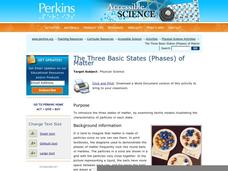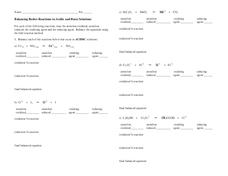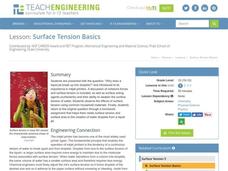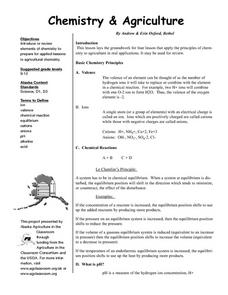Science Matters
Basic Needs
Scholars take part in a grand conversation about the basic needs of living things. Working collaboratively, pupils brainstorm and identify similarities to come to the conclusion that the environment meets the needs of all living things.
Curated OER
Basic Needs of Living Things - Lesson One
An interesting way of teaching about basic needs of different organisms awaits your fourth graders. Pupils take part in class discussions and demonstrations which should lead to a greater understanding of how to determine basic needs. As...
Curated OER
Basic Needs of Living Things - Lesson Two
Fourth graders study and identify the basic needs of a variety of organisms. Terrariums and aquariums are used to demonstrate what plants, animals, and fish need to stay alive. These two classic models are used to effectively convey what...
Perkins School for the Blind
Building a Basic Series Circuit
Make science a fully accessible subject for your learners with visual impairments. They'll use tactile models to explore the nature of basic electrical circuits. Template board, wires, batteries, and Velcro are used to construct the...
Perkins School for the Blind
The Three Basic States (Phases) of Matter
There are three basic states of matter: Solid, liquid, and gas. Help your learners with visual impairments to understand the chemical nature of each state of matter with tactile elements. Marbles are used to model the particles in each...
Curated OER
Habitat Basics
First graders get out and explore two different habitats to examine how each one meets the needs of the plants and animals that dwell there. They discuss what they've learned about animal habitats as they explore the outdoor environment....
Curated OER
Balancing Redox Reactions in Acidic and Basic Solutions
Five acidic and five basic solutions are listed for your chemistry apprentices to review. For each, they must state which atom or ion is being oxidized or reduced, and then name the oxidizing or reducing agent. Finally, they balance each...
Teach Engineering
Surface Tension Basics
Back to the basics (of surface tension). The first installment of a nine-part series teaches young scholars about the basics of surface tension and how it relates to water droplets. They also learn how this concept allows for the...
Curated OER
DNA Basics, Bacterial Cell Walls
Some basic descriptions of DNA and the appearance of structures in a bacteria are included along with great diagrams. The presentation has clear, but detailed slides, and your students will find the information about Gram staining easy...
T. Trimpe
Atomic Basics
Get down to basics with these worksheets on the structure of atoms. Challenging young chemists to identify information from the periodic table and create Bohr diagrams and Lewis dot structures for different elements, this resource would...
Science Teachers
Basic Periodic Table of the Elements
This basic, black-and-white printable is a copy of the periodic table of elements. It includes the standard element name, symbol, atomic number, and atomic weight. Across the bottom is an explanation that says for elements without stable...
Curated OER
Basic Needs of Plants
Second graders conduct a plant experiment. In this basic needs of plants lesson, 2nd graders observe plants for two weeks. Students record data from their plants in journals.
Curated OER
Basic Needs of Living Things-Lesson One
Fourth graders explore the basic needs of living things. They observe a variety of living things and identify the basic needs of each living item. Students create food balls of peanut butter and nuts to feed animals. They hang their food...
Curated OER
Basic Needs of Plants
Fourth graders explore the four basic needs of plants. They examine plants as they grow. Students discuss the changes that they see in the growing plants. They observe what happens to a plant when one of its basic needs is taken away.
Curated OER
Periodic Behavior of Oxides
Students investigate the properties of oxides and observe their periodic trends. In this behavior of oxides lesson plan, students experiment with metallic oxides and non-metallic oxides to determine if they are acid, basic or amphoteric...
Curated OER
Energy and Change: The Five Basic Laws
Five basic law of physics and energy are listed here, with a simple explanation of what each actually means in the real world! Your young physicists will appreciate the concepts being made more relevant and the language being made more...
Teach Engineering
Weather Basics
Weather — there's more to it than meets the eye of the storm. With this resource young meteorologists learn about the basics of weather, including information about the factors that influence the weather, common weather vocabulary, and...
Curated OER
Basic Chemistry Principles
Students use the basic principles of Chemistry to determine pH levels. Elements of the Periodic Table are also included in this lesson.
Curated OER
Basic Cell Structure
Initially, general details about cells and single cell organisms are provided. Next, the concentration becomes cellular processes such as respiration, osmosis, diffusion, fission and mitosis. This is an attractive PowerPoint which gives...
PhET
Molecule Shapes: Basics
In molecules, bonds rotate about the nucleus due to the repulsion of subatomic particles. In a simulation, learners manipulate the bonds of a molecule to meet the atoms' needs. They can then see the specific molecular shapes of five...
PHET
Energy Skate Park: Basics
Keep calm and half pipe. An exciting simulation teaches pupils about energy transfer from potential to kinetic and thermal as a skater moves through a half pipe or other track. After a brief introduction, scholars can build their own...
PHET
Forces and Motion: Basics
How is tug of war related to pushing a refrigerator? Here's a simulation connects these two activities with Newton's First Law of Motion. Four different simulations allow scholars to explore net force with tug of war, motion with pushing...
Curated OER
The Nervous System: Basic Organization and Function
A vintage learning exercise on the basic structure and function of the nervous system awaits your beginning biologists. Although it pertains to a textbook chapter reading, the content is relevant to any introductory unit on the nervous...
Curated OER
Energy Basics
As the title says, some basics of energy are given here. The first section of the slide show focuses on heat energy, differentiating between it and temperature. Chemical and sound energy are introduced, and then the three are combined to...
Other popular searches
- Basic Needs
- Basic Map Skills
- Basic Division
- Basic Math
- Basic Human Needs
- Basic Needs of Plants
- Basic Needs of Animals
- Basic Electricity
- Basic Needs and Wants
- Basic Accounting
- Basic Banking
- Basic Math Skills

























